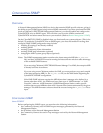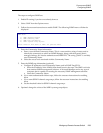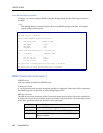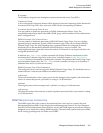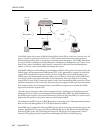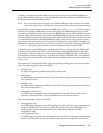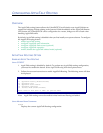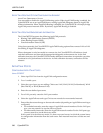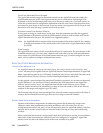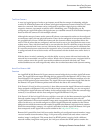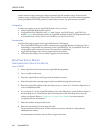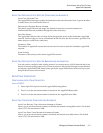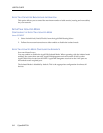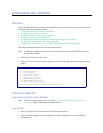
USER’S GUIDE
306 CyberSWITCH
APPLETALK ROUTING OPTION CONFIGURATION ELEMENT
APPLETALK OPERATIONAL STATUS
You can enable or disable the AppleTalk Routing option. When AppleTalk Routing is enabled, the
CyberSWITCH acts as an AppleTalk Router, routing AppleTalk datagrams based on AppleTalk
address information. When AppleTalk Routing is disabled, the CyberSWITCH will simply bridge
AppleTalk protocol network traffic. By default, AppleTalk Routing is disabled.
APPLETALK ROUTING BACKGROUND INFORMATION
The CyberSWITCH supports the following AppleTalk protocols:
• Routing Table Maintenance Protocol (RTMP)
• Name Binding Protocol (NBP)
• Zone Information Protocol (ZIP)
Using these protocols, the CyberSWITCH AppleTalk Routing option allows remote LAN to LAN
forwarding of AppleTalk datagrams.
When a datagram is to be forwarded to a remote site, the CyberSWITCH will initiate a circuit
switched connection and forward the appropriate datagrams to that remote site. As the link
utilization increases, the CyberSWITCH will make additional connections as required to provide a
consistent level of performance to the device. As link utilization decreases, connections will be
released.
APPLETALK PORTS
CONFIGURING APPLETALK PORTS
USING CFGEDIT
1. Select AppleTalk Ports from the AppleTalk configuration menu.
2. Press 1 to add a port.
3. Select the type of port you are adding. Choices are LAN, WAN, WAN (UnNumbered), WAN
(Mac Dial In), or WAN (Remote LAN).
4. Enter the user-defined port name.
5. For a LAN port only: enter the LAN port number.
6. Select the AppleTalk network type. Choices are extended or nonextended network.
7. Enter either the network range or the network number (depending on AppleTalk network type
configured).
• For extended networks: enter the range of AppleTalk network numbers. For the LAN port
type, you may enter 0-0 to use the discovery mode.
• For nonextended networks: Enter the AppleTalk network number. For the LAN port type,
you may enter 0 to use the discovery mode.
If the system is in the discovery mode, it is then a non-seed router, in which the system learns
its configuration information from the seed router. Each network must have at least one seed
router.



